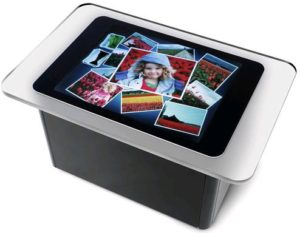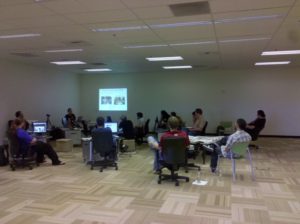 Once upon a time, Microsoft Surface was affectionately known as the Big Ass Table. I got the incredible opportunity to work at Surface several years after BAT – a new and improved table, Surface V2, was in the MSFT works.
Once upon a time, Microsoft Surface was affectionately known as the Big Ass Table. I got the incredible opportunity to work at Surface several years after BAT – a new and improved table, Surface V2, was in the MSFT works.
A new marketing group formed in the wake of Surface V1 marketing campaigns such as “Virtual Wingman” and extensive partnership efforts with hotels, casinos, and restaurants. With a $10,000 pricetag Surface wasn’t quite ready for the average consumer target market. Surface V2 aimed to bring the cost to something more reasonable and physically streamline the flagship product. The team partnered with Samsung for hardware and the exciting/challenging task of making the Surface SDK talk to the new hardware began.

I was hired to work on another Microsoft Testing and Adoption Program then, to help early adopters (developers) learn about and build apps that showcase Surface V2 powers. I had experience as a Microsoft TAP manager and with Microsoft’s XNA framework, then a development mode in the Surface SDK. V1 had tagged object recognition (you could put things on the table and it could understand what they were), massive multitouch (it supported 52 simultaneous touch events), and directional touch recognition (it knew what side of table you were on). Surface V2 enabled the prior, but with rear camera touch detection eliminated (touch was now a per-pixel sensor input), the new form factor enabled it to act as a regular display with vertical mounting. It was my job to help app developers show what it could do.
New hardware development can be quite an awkward and lengthy process. Stuff doesn’t always work as intended, especially when you’re dealing with firmware, sensors, radios, or unpredictable data streams. Perfecting and evolving the required tech takes years and lots of resources. Promises are broken to eager and expecting customers, almost never because of bad intention or lousy planning.
Hardware is point-blank hostile business-wise – the “hard” part in hardware is no joke (I learned this again when working on secure mobile devices in Berlin). It’s difficult to change or adapt quickly based on easily consumable metrics, as you’d be able to with web app development. One must be tenacious, determined and ready for unanticipated failures and surprising incompatibilities both technically and usability-wise. Above all, you have to be able to laugh, remain patient and have fun with it, otherwise, why do it?

This was hands-down my favorite job at Microsoft – I adored my TAP partners and we worked hard while having fun as a team. I had an incredibly supportive lead and I can’t thank him enough for his care and mentorship – he helped me grow confident and capable as a manager and I’m surprised I accomplished as much as I did in one short year.
We started Surface After Dark, an after-hours development community, which turned into Surface Labs, which turned into Surface Garage. The latter was featured on TechCrunch. We took Surface to PAX and the Microsoft Science Fair together, to name a few group events. We shared ideas and code, and spent countless hours coming up with new possibilities for Surface. I developed my management “persona” there, and when I look at my weekly TAP status update presentation imagery, littered with random themes such as David Hasselhof, 80s hair bands and unicorns, I’m proud to say we made it to the CES 2011 stage in smiles and laughter.
In 2012, Microsoft Surface V2 became Microsoft PixelSense and the Surface branding shifted to the Surface we know and love today. I got a full time position as a Technology Evangelist at Microsoft thanks to my work on Surface.
Windows Central offers a pleasant overview of the Surface Table and it’s history. Perhaps even more interesting is an old article about Amnesia Connect which assists the transfer of content from a device (e.g. cell phone) to the table. As you can see, things like security may not have been a top priority in 2011, but such is the nature of early innovation. The Surface development community has been by far my favorite to work with and my experience working on this team has been very tough to beat.

